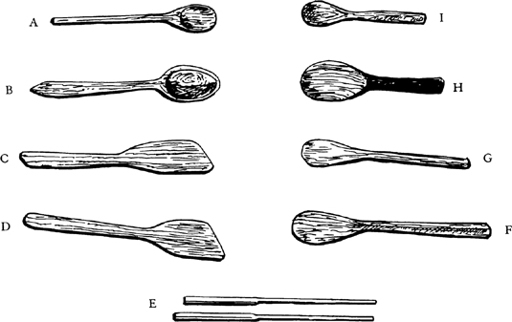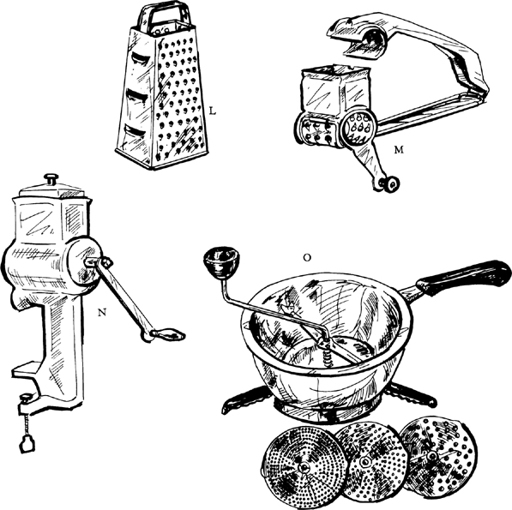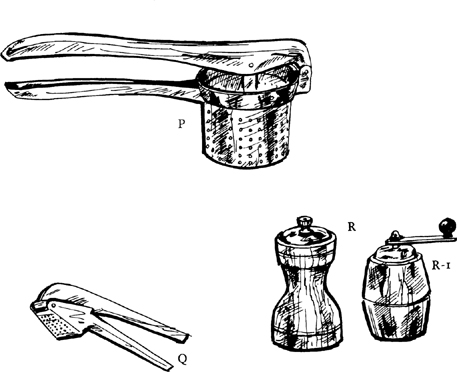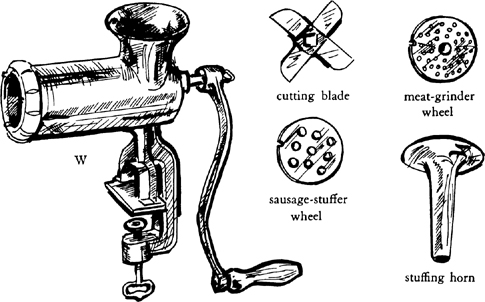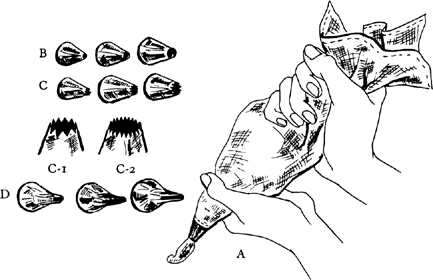Mastering the Art of French Cooking, Volume 2 (222 page)
Read Mastering the Art of French Cooking, Volume 2 Online
Authors: Julia Child

WOODEN SPOONS, SPATULAS, AND CHOPSTICKS
Why stir it with a wooden spoon? Because it blends the flour and butter
roux
without racket, and it scrapes the coagulated roasting juices into the deglazing sauce with more quiet efficiency than metal against metal. Actually, the French bowl-less wooden spatula (I,G,F), or the Japanese wooden spatula (H), or the no-stick spatula implements (C and D) are far more useful for every stirring, scraping, mixing, and beating job than the wooden spoon (A and B). Do not forget wooden chopsticks (E); they will beat the eggs for the omelette, lift the green bean out of the boiling pot for testing, and turn the bacon.
GADGETS AND MISCELLANY
Opening, prying, and poking operations will be easier on fingers and tempers when you have something like A or C for screw-topped jars, or the all-purpose-everything item, B. The French tool, G, is for cans and general prying, while the box-opener-hammer-hatchet-etc. instrument, D, is useful anywhere. Ice picks, both the single-pointed F, and the 5-pronged E, are multi-purpose musts. Citrus zesters H and J are good for bar as well as kitchen, and the potato ballers I and K are useful for fruits and vegetables alike.
For grating, puréeing, and grinding, some hand-operated gadgets do a better job than the electric blender or mixer. Use 4-sided grater, L, when you want to grate orange rind or you need coarsely grated Swiss cheese, or a few slices of carrot; look for one in stainless steel. When grated cheese is to be spread over the
sauce Mornay
, hold the little French rotary grater, M, right over the
gratin
dish. The table model, N, is for great mounds of cheese if you do not have a grating attachment for your electric mixer.
Again, in spite of the marvels of the electric blender, you do need an efficient food mill for applesauce, puréeing soups, turnips, artichoke hearts, and canned Italian plum tomatoes. The French model, O, with removable disks and folding rubber-padded feet is still the best, in our opinion. One with a top diameter of 9 inches is the standard size; if you are having more than one, the 7-inch size is handy for small jobs like sieving hard-boiled egg yolks.
The old-fashioned potato masher, P, is not to be ignored, nor is the rectangular-headed garlic press, Q. Beware of faulty designs, however, especially in garlic presses. These should take a quite large, whole, unpeeled clove of garlic; the point is that you do not have to peel the garlic. The rectangular head allows a reasonably large clove to be puréed, and the holes should be just the right diameter for the press to do its work easily; if the one you buy does not perform as you think it should, take it back and demand a refund. Get yourself a good peppermill for the kitchen; the French Peugeot models (R and R-1), are always reliable.
Public performances are long when the flame lies low; chafing-dish heat elements are for cooking, and must provide proper heat. Unless you want the efficient gas-operated model, T, look for the kind that will hold a whole can of solidified alcohol, S, and that has an opening which will give you a large heat source.
The French salad basket, U, also comes with a rotary ratchet-gadget that spins salad greens dry in a jiffy. The basket for the Swiss model, V-1, fits into a container, V-2, which catches all the splattering water as the lettuce leaves whirl inside it.
If you do not have a meat-grinder attachment for your electric mixer, buy yourself a sturdy table model, W, always picking the large size for quick and easy operation. Many
grinders come with the sausage-stuffing horn you will need for the
charcuterie
recipes (see illustrations).
THE PASTRY BAG
From squeezing out cream puffs to making meringue cakes and potato borders, nothing will do the work as easily nor with as professional a look as the pastry bag (A) with its collection of interchangeable metal tubes. Buy the big professional, washable, canvas bags, 12, 14, and 16 inches long; in comparison with your other kitchen equipment, these are inexpensive, and so are the metal tubes. For a start, get 2 or 3 tubes with plain round openings varying from ¼ to ¾ inch in diameter (B), and a cannelated group of the same dimensions (C). Among the latter, the widely spaced teeth (C-1) are for rough masses like potatoes
duchesse
, while the fine teeth (C-2) are for icings. Ribbon tubes, both plain and cannelated (D), are used particularly for such decorations as the meringues for the
Saint-Cyr
; one of each, ¾ inch wide, should be sufficient.
